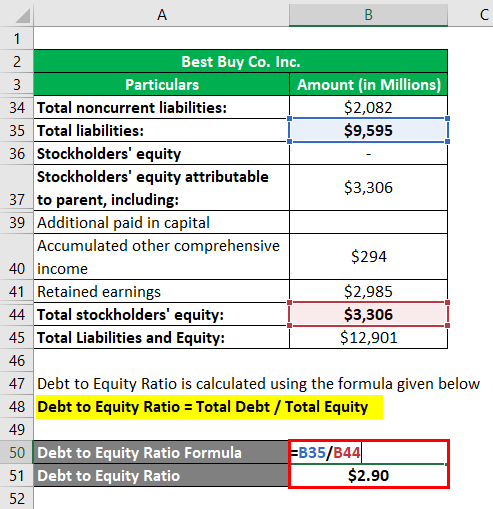
However, if that cash flow were to falter, Restoration Hardware may struggle to pay its debt. You can find the balance sheet on a company’s 10-K filing, which is required by the US Securities and Exchange Commission (SEC) for all publicly traded companies. Investors can use the D/E ratio as a risk assessment tool since a higher D/E ratio means a company relies more on debt to keep going.
What is a Good Debt to Equity Ratio?
This in turn makes the company more attractive to investors and lenders, making it easier for the company to raise money when needed. However, a debt to equity ratio that is too low shows that the company is not taking advantage of debt, which means it is limiting its growth. This is because ideal debt to equity ratios will vary from one industry to another.
How Businesses Use Debt-to-Equity Ratios
However, such a low debt to equity ratio also shows that Company C is not taking advantage of the benefits of financial leverage. In most cases, a low debt to equity ratio signifies a company with a significantly low risk of bankruptcy, which is a good sign to investors. Debt to equity ratio also affects how much shareholders earn as part of profit. With low borrowing costs, a high debt to equity ratio can lead to increased dividends, since the company is generating more profits without any increase in shareholder investment. While this limits the amount of liability the company is exposed to, low debt to equity ratio can also limit the company’s growth and expansion, because the company is not leveraging its assets. If a company has a low average debt payout, this implies that the company is obtaining financing in the market at a relatively low rate of interest.
What Type of Ratio Is the Debt-to-Equity Ratio?
- If the company were to use equity financing, it would need to sell 100 shares of stock at $10 each.
- Plans are not recommendations of a Plan overall or its individual holdings or default allocations.
- Conversely, a lower ratio indicates that the company is primarily funded by equity, implying lower financial risk.
- Generally, a ratio below 1 is considered safer, while a ratio above 2 might indicate higher financial risk.
- As an example, the furnishings company Ethan Allen (ETD) is a competitor to Restoration Hardware.
- If a company’s D/E ratio is too high, it may be considered a high-risk investment because the company will have to use more of its future earnings to pay off its debts.
Because debt is inherently risky, lenders and investors tend to favor businesses with lower D/E ratios. For shareholders, it means a decreased probability of bankruptcy in the event of an economic downturn. A company with a higher ratio than its industry average, therefore, may have difficulty securing additional funding from either source. A decrease in the D/E ratio indicates that a company is becoming less leveraged and is using less debt to finance its operations.
Investors may check it quarterly in line with financial reporting, while business owners might track it more regularly. Currency fluctuations can affect the ratio for companies operating in multiple countries. It’s advisable to consider currency-adjusted figures for a more accurate assessment. In this guide, we’ll explain everything you need to know about the D/E ratio to help you make better financial decisions. Our writing and editorial staff are a team of experts holding advanced financial designations and have written for most major financial media publications.
While this can lead to higher returns, it also increases the company’s financial risk. Capital-intensive sectors, such as utilities and manufacturing, often have higher ratios due to the need for significant upfront investment. In contrast, industries like technology or services, which require less capital, tend to have lower D/E ratios. Generally, a ratio below 1 is considered safer, while a ratio above 2 might indicate higher financial risk.

Finance Strategists has an advertising relationship with some of the companies included on this website. We may earn a commission when you click on a link or make a purchase through the links on our site. All of our content is based on objective analysis, and the opinions are our own. This is helpful in analyzing a single company over a period of time and can be used when comparing similar companies. It is important to note that the D/E ratio is one of the ratios that should not be looked at in isolation but with other ratios and performance indicators to give a holistic view of the company.
Again, context is everything and the D/E ratio is only one indicator of a company’s health. Investors who want to take a more hands-on approach to investing, choosing individual stocks, may take a look at the debt-to-equity ratio to help determine whether a company is a risky bet. Investors can use the debt-to-equity ratio to help determine potential risk before they buy a stock.
Publicly traded companies that are in the midst of repurchasing stock may also want to control their debt-to-equity ratio. That’s because share buybacks are usually counted as risk, since they reduce the value of stockholder equity. As a result the equity side of the equation looks smaller and the debt guide to the nanny tax for babysitters and employers side appears bigger. Ultimately, businesses must strike an appropriate balance within their industry between financing with debt and financing with equity. In addition, there are many other ways to assess a company’s fundamentals and performance — by using fundamental analysis and technical indicators.

Commenti recenti